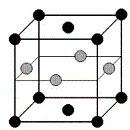Department of Physics and Astronomy: Publications and Other Research

Ralph Skomski Publications
Document Type
Article
Date of this Version
July 2007
Abstract
The temperature dependence of the spin polarization of type-I half-metallic ferromagnets is investigated and compared with that of other magnetic materials, such as semimetals, strong and weak ferromagnets, and exchange-enhanced Pauli paramagnets. Stable atomic moments, as realized by strong intra-atomic exchange, exhibit a nonzero spin-down density of states (DOS) at finite temperatures. This thermal spin mixing means that the conductivity of the “insulating” spin channel is always nonzero and that half-metallic ferromagnetism is an idealized limit. At zero temperature, similar effects are caused by intersublattice interactions, spin–orbit coupling and crystal imperfections. With increasing interatomic hopping, the moment becomes unstable, and Stoner-type thermal excitations yield an additional reduction of the spin polarization. In the Stoner limit, the hybridization gap closes far below the Curie temperature, and the corresponding transition temperature T* increases with increasing hybridization gap and decreasing band width. Correlations are analyzed by a version of the Kondo model and by an unrestricted Hartree–Fock approximation, and it is argued that correlations are less important than the leading one-electron contributions.


Comments
Published in Journal of Physics: Condensed Matter 19 (2007) 315202 (14 pp); doi:10.1088/0953- 8984/19/31/315202. Online at http://stacks.iop.org/JPhysCM/19/315202 Copyright © 2007 IOP Publishing Ltd. Used by permission.